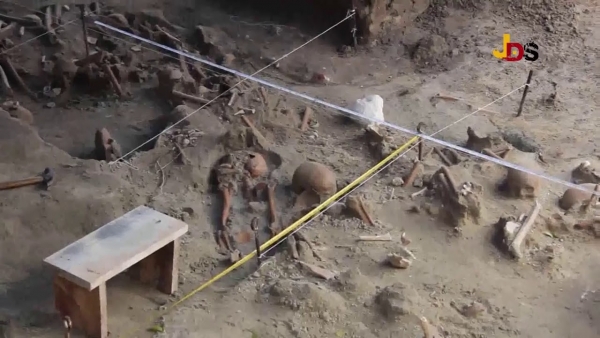The Office on Missing Persons (OMP) observed the process of selecting six bone samples for radiocarbon dating at the Mannar mass grave, located at the Sathosa Building in Mannar town.
The process of selecting samples was carried out at the excavation site under the auspices of the Mannar Magistrate, T. Saravanaraja. The team carrying out the sample selection included representatives from the Consultant Judicial Medical Officers, the Post Graduate Institute of Archaeology from the University of Kelaniya, the Police (Scene of Crime Officers – SOCO and crime investigation branch), and the Government Analysts Department.
OMP Commissioners Mirak Raheem and K. Venthan were present as observers. Lawyers representing families of the disappeared and a member from the Citizens’ Committee were also present as observers.
Radiocarbon dating calculates the amount of Carbon-14 in bone and teeth samples and establishes the approximate time when an animal or plant was alive. It is a form of testing used in archaeology and forensic science for dating human remains. The samples from the Mannar mass gravesite will be sent to a laboratory abroad which specializes in bomb pulse carbon 14 technique. In cases where the skeletons belonged to persons that died after World War II, bomb-pulse carbon 14 dating can provide a narrower range of time periods in which the deaths occurred.
The Consultant Judicial Medical Officer, District General Hospital Mannar, Dr Rajapaksha noted that “After 118 working days we have unearthed two hundred and seventy-eight skeletons, which includes remains of men, women and children. There are some damages to the bones, but it is only upon further investigation that we can determine if these are antemortem or postmortem injuries, and whether it relates to the cause of death. Our task has been to gather evidence to determine the cause of death, time since death, the contributing circumstances and the specific identity of the individuals in this site, and also determine if all the skeletons are from the same historical period or different periods, while ensuring the integrity of the site and chain of custody of remains and other evidence.”
Dr Rajapaksha heads the investigation team and is assisted Professor Raj Somadeva who leads the archaeological team. Six samples were selected to represent the different areas and vertical layers of the site. Human remains had been excavated from the site as complete skeletons and as comingled bones. From complete skeletons, a tooth and a section of the femur bone was selected. From the comingled bones only the femur or where it was unavailable a tooth.
The samples were extracted, cleaned, dried, sealed and labelled over the course of three days. Following the samples being tested at a laboratory and the results being submitted, a preliminary combined excavation report including the test results and other findings will be submitted by the investigation team to the Magistrate Court.










